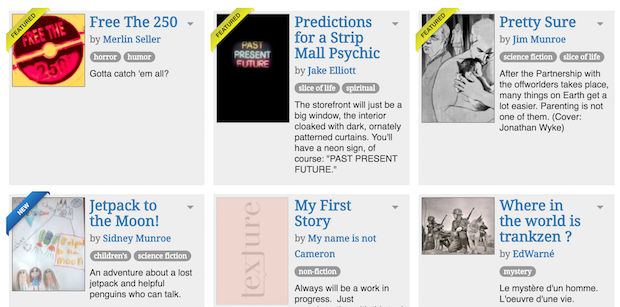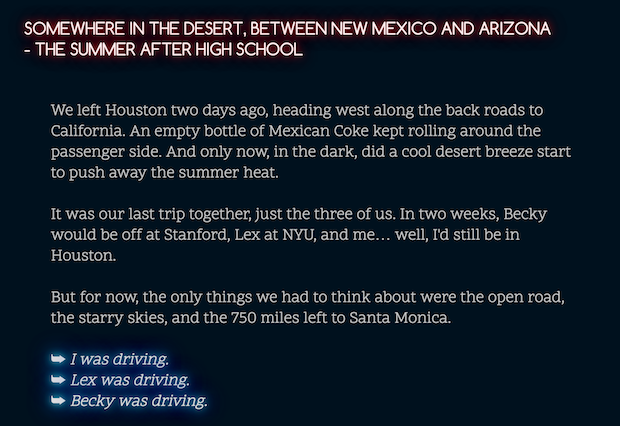IF Only: Looking back at 2016 in Interactive Fiction
Trends and recommendations
We have, at last, reached the end of 2016. I'm not going to do a top-ten list — both because a lot of the games I might put on this list are things I've already covered elsewhere in previous columns, and because I think some of the most interesting things to happen in 2016 were about trends rather than single hits. But here are a few highlights of the year past.
New Commercial Work
Choice-based commercial IF has been quietly thriving for years now: Choice of Games steadily commissions new interactive novels, and Failbetter Games continues to develop new storylines for Fallen London. (I have done some work for both of these companies. Normally I'd leave this point for the disclaimer, but that's a sufficiently major disclosure I feel like I should put it where it won't be missed.)
The variety of new IF on mobile platforms is even more vibrant, but of course we are not allowed to talk about that here. It exists, though. Trust me. It's out there.
Commercial parser IF is much rarer, because it tends to involve substantially more work to produce while reaching for a significantly smaller audience. Also, many of the toolsets for creating IF aren't especially designed to make custom UIs easy. In spite of all that, 2016's output was non-zero: Interactive Fables came out with Worldsmith, an Inform game with a custom interface layer that adds new graphical features. Worldsmith is a big, ambitious game: it starts out with a non-trivial simulation portion that is essentially a god-game in text, and that's just the scene-setting introduction.
I am ashamed to admit I still haven't finished the whole game because I wound up restarting the intro several times; and there's also quite a lot of introductory tutorial material to read through before you can really get rolling. But the reviews from the people who did finish the game are enthusiastic. So if you're interested in supporting parser IF, or curious about what goes on in that space, or want something really substantial to play over your holiday, that might be worth a look.
Lifestream (Storycentric Worlds) is not parser-based, and I haven't had a chance yet to play it either. The screenshots suggest a familiar rooms-and-inventory model with plenty of text.
Logic Puzzle IF
Some IF goes very light on the fiction and focuses most on the puzzles. There's always been a trend for that, but in the last few years we've seen the development of a distinct niche where the game is a logic puzzle with only very light attention to narrative plausibility.
This year, those releases include three Peterkin Investigates logic puzzle murder mysteries (the kind where you may find yourself writing down a grid diagram as you play) from Christopher Huang.
Inside the Facility, from Arthur DiBianca, is a solid and inventive game you play entirely by moving north, south, east, or west, or waiting: again, you should expect to take notes if you want to get through it, but the game comes with a grid map to fill in, and I found it pretty entertaining approached as a crossword rather than primarily as a story.
Even more hardcore than Inside the Facility, Andrew Schultz's Fourdiopolis builds a combination of word-play puzzle and spatial reasoning. Schultz has an extensive back-catalog of wordplay puzzle games, but this one is particularly serious and unforgiving.
And if you'd rather dip into the lighter end of this style of play, you might like Brian Kwak's reasonably accessible How to Win at Rock Paper Scissors. (I got through that one without needing any notes, which sets it apart from anything else in this section.)
Interactive Poetry, Interactive Art
There's a growing subgenre of Twine and other hypertext pieces that engage strongly with the words themselves, treating them as the primary object of manipulation. Pippin Barr's Burnt Matches presents a landscape entirely made of nouns, which ripple or change color or move under the touch of the cursor.
Porpentine continues to write — though increasingly in ways that don't address the games space at all. This year I particularly enjoyed her Vesp (for Vice); also Miss Clemory & the Wall of Fire, which contains some superb lines. She is also part of the Whitney Biennial 2017, a forthcoming survey of contemporary art in the US.
The Seers Catalogue is not exactly interactive poetry, but it is surreal in a way that sets it apart from a lot of the work typically found in the IF community. (This piece doesn't run in Safari, but Chrome and Firefox should handle it.)
Then there's literary hypertext — historically a genre of material written mainly by academics with a different toolset and little overlap with interactive fiction in either writers or readers. This year, Mark Bernstein released Storyspace 3, the latest version of his tool for "serious hypertext," as well as an interactive novel written with it, Those Trojan Girls. The effect is consciously writerly and the mechanics are a little challenging, even for people with a lot of Twine experience. But I think some mutual contact between genres is important, and tends to be instructive for both sides.
Speaking of which, another major trend of 2016:
Formal Cross-pollination
The line between choice-based and parser-based IF is getting blurrier and blurrier. There are more IF works with a choice-based interface that also offer some kind of world model, a core gameplay loop, or a significant amount of player intention. And there are more parser games that have an untraditional world model or that use text input in an unusual way.
2016 is hardly the beginning of this trend: we can find parser games on unusual models going back for years: consider Kazuki Mishima's Pale Blue Light, which periodically accepts freeform text entry. Or Katherine Morayati's Laid off from the Synesthesia Factory from IF Comp last year, which keeps moving the story forward regardless of what you type, but allows the player to guide the focus of its narration.
But a number of games this year built on those traditions, including CEJ Pacian's Superluminal Vagrant Twin or the other limited parser works I covered back in June. Some of these games reduce the number of verbs but significantly increase the range of available nouns — consider Morayati's 2016 IF Comp game Take, which riffs on the media meaning of the old standby text adventure verb, where you go around having hot takes on things; or Chandler Groover's IF Comp entry Mirror and Queen, in which the player interrogates a magic mirror.
That particular structure — few or no verbs, but many nouns — shifts the gameplay from the realm of action to the realm of contemplation. Often there are many more terms implemented than in a typical parser game, and sometimes those terms include abstract concepts as well as the physical objects one might usually expect. At the same time, the effect is very different from the contemplative-but-restricted feel of a Twine game, where the possibility space for thought is typically spelled out, visible, overt. Take, Mirror and Queen, Chandler's previous piece Toby's Nose — are all partly about discovery and exploration; about guessing which topics will be fruitful to explore, and pursuing those leads. It is not a million miles from the Her Story mechanic.
Then there are games with a traditional world model but a more accessible way of manipulating that model. Robin Johnson got quite a bit of traction with the hybrid engine he used for both Draculaland and the IF Comp-winning Detectiveland. The interface combines the feel of a parser IF world model with discoverable buttons.
Meanwhile, Abigail Corfman released a couple of Twines with significant gameplay features. Both her IF Comp entry 16 Ways to Kill a Vampire at McDonalds and her larger Open Sorcery let the player solve puzzles. 16 Ways feels fairly similar to a traditional parser game, complete with rooms and inventory, while Open Sorcery's mechanic is a little more surprising, but both are playing within that space of providing a room model.
I'd also recommend Lethophobia, a fantasy/sort-of-horror piece by Olivia Wood and Jess Mersky, which uses the looseness and freedom of StoryNexus to simulate a particular house environment. It's evocative, mildly puzzly but not overwhelmingly so, and a prime example of a quality-based narrative system being used for rooms-and-objects storytelling.
2016 also brought us a major new tool in this area. Texture, previously in beta, got a significant upgrade with new functionality and a new library website — enough in my opinion to push it across the line from "interesting concept but currently underpowered" into "functional." Not every project is the ideal Texture project, and I've seen complaints from people with particularly large screens that the dragging mechanic can become a burden in that space. Personally, though, I find it quite playable in a laptop, and I find that it allows for writing games with a discoverable mechanic (unlike parser games) but where there's still that vital gap between the player thinking of what they want to do, and the player being able to perform that function.
The result has been a substantial set of new Texture games — perhaps not on the same scale as the year's output in Twine, ChoiceScript, or other established languages, but still a very good showing for a new tool. IF languages and toolsets typically take some time to get significant uptake, but Texture is both easy to use and clearly different from other works in the space. B Minus Seven's piece Relentless Drag pulls the concept in a surprising direction.
Hugo's Not Dead Yet
Hugo is an IF creation language familiar to those of us who were paying attention in the late 90s and early 00s. While it never built up quite as large an author community as TADS or Inform, Hugo had some major fans, and it dealt gracefully with images when a lot of other systems didn't. Hugo's creator, Kent Tessman, even built a commercial parser IF game with it, called Future Boy.
Another real star author of Hugo was Robb Sherwin, whose profane and memorable main characters racked up numerous XYZZY nominations for dialogue: Robb's works included Necrotic Drift, in which you played an ex-D&D champion called upon to vanquish some genuine monsters at a mall, and Cryptozookeeper, in which you're tracking down such fine contraband items as alien bone jelly.
Still, these games tended to require interpreter downloads in order to play, which make them more of a challenge to recommend to novices these days. But no longer. 2016 sees the release of a website that runs Hugo games online, so you can try out Cryptozookeeper yourself with no special commitment.
A Few Last Favo(u)rites
These aren't necessarily exemplars of any specific trend, but they're games I particularly liked this year, and I don't want to close the column without mentioning them.
Cactus Blue Motel, Astrid Dalmady, from IF Comp. Strong sense of setting and unusual use of jackalope.
Three Card Trick, Chandler Groover. Creepy, comically sinister game about competing magicians.
What Fuwa Bansaku Saw, also Chandler Groover, a parser-based tale about a haunted shrine. (This guy is incredibly prolific and his work is also extremely varied.)
[Disclosures: Emily has a current contract with Choice of Games and contributes to Fallen London. She has met Astrid Dalmady, Katherine Morayati, and Robb Sherwin. She was a beta-tester for Laid off from the Synthesia Factory. She once received a marriage proposal from Olivia Wood but it wasn't serious. More generally, Emily Short is not a journalist by trade and works professionally with various interactive fiction publishers. You can find out more about her commercial affiliations at her website.]











